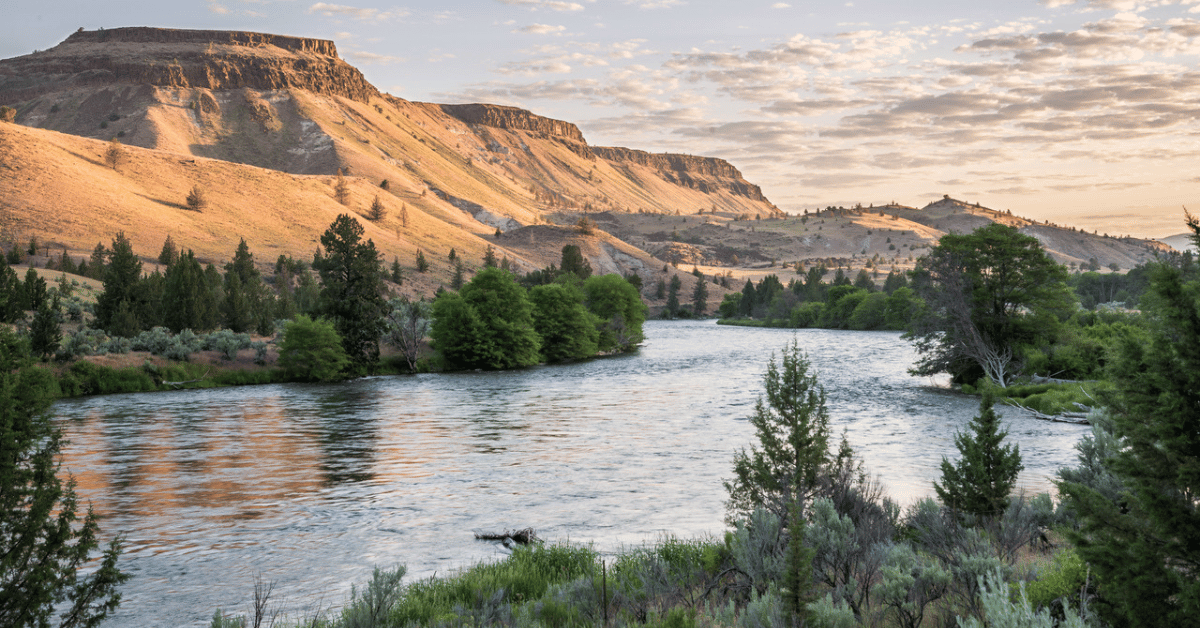
I grew up hiking, fishing, and camping along the banks of the Metolius and Deschutes rivers in central Oregon. Though close in proximity to my childhood home in Bend, spending time at these rivers would transport me somewhere far away. Somewhere wild. Entire summer days spent casting flies at trout, searching for crawdads along the banks, and running through the woods would fly by. I didn’t realize it at the time, but there is a reason those woods remain wooded, the fish habitat is still intact, and the rivers run free. In 1988, seven years before I was born, many of Oregon’s most iconic rivers–including the Metolius and Deschutes–were designated as Wild & Scenic, ensuring these natural treasures would remain wild and undeveloped for future generations to come.
On October 28, many Oregon rivers will be celebrating 35 years of Wild & Scenic River protections. This includes rivers like the McKenzie, John Day, Clackamas, Salmon, North Umpqua, and Grande Ronde. Just like me, there’s a good chance one of your favorite Oregon rivers was included in this legislation!
Years of grassroots activism by Oregonians from all corners of the state advocating for their favorite trout streams, camping spots, whitewater runs, hiking trails, and wild rivers led to the creation of the 1988 Omnibus Oregon Wild & Scenic Rivers Act, protecting over 40 river segments and 1400 total river miles across the state. Oregon Wild, then known as the Oregon Natural Resources Council, played a pivotal role in getting the bill passed through Congress.
Thirty-five years later, this legislation is still the largest single act of river conservation in Oregon’s history. Despite that and subsequent bills, only 2% of the state’s total stream miles are designated as Wild & Scenic. We need to do better.
Fortunately, we have a historic opportunity to protect over 3200 miles of new Wild & Scenic Rivers through Senator Wyden’s River Democracy Act. The bill includes clean drinking water sources for the cities of Bend, Eugene, Medford, Oregon City, and others. It also safeguards popular fly fishing streams like the Fall River and North Santiam, world-class whitewater runs in the Rogue River basin, and miles and miles of critical salmon and wildlife habitat. If passed, the River Democracy Act would surpass the 1988 Act as Oregon’s largest river conservation feat, increasing Wild & Scenic designation to 5% of the state’s stream mileage. That would mean families could create new memories fishing for salmon on the South Fork Alsea River, the water managers for Eugene won’t need to worry as much about runoff and increased filtration costs from a clearcut in the McKenzie watershed, and kids can glimpse their first elk migrating through a protected wildlife corridor along Tumalo Creek near Bend.
Just like the 1988 bill, the River Democracy Act is the result of a multi-year grassroots process and the work of hundreds of river enthusiasts nominating and advocating for their favorite rivers. The bill has broad support from over 50 local breweries, 250 additional Oregon businesses, 75 community organizations, 26 fisheries biologists, hunters and anglers, and thousands of Oregonians.
I feel lucky to have grown up in Oregon and enjoyed the benefits of having protected Wild & Scenic Rivers in my backyard. I also know that the work is not done as there are so many rivers still out there deserving of these important safeguards. The River Democracy Act provides a once-in-a-generation opportunity to ensure more Oregonians can enjoy these special places, the lifeblood of our state.
Join the fight to protect Oregon’s rivers and take action by encouraging our Senators to advance the River Democracy Act!
What is a Wild & Scenic River?
Created by Congress in 1968, the National Wild & Scenic Rivers System was enacted “to preserve certain rivers with outstanding natural, cultural, and recreational values in a free-flowing condition for the enjoyment of present and future generations.” Wild & Scenic River designations protect a ¼ or ½ mile buffer on each side from new dam construction, new mining claims, clearcutting, and other activities that would degrade the river’s water quality and natural values. Activities like fishing, kayaking, skiing, camping, hunting, etc are allowed to continue and often can be enhanced. Learn more about Wild & Scenic rivers here.
Wild & Scenic Metolius River by Kaylee Graham
Wild & Scenic North Umpqua River by Lucas Rietmann

